
Macaranga is a large genus of Old World tropical trees of the family Euphorbiaceae and the only genus in the subtribe Macaranginae. Native to Africa, Australasia, Asia and various islands of the Indian and Pacific Oceans, the genus comprises over 300 different species. It was first described as a genus in 1806, based on specimens collected on the Island of Mauritius.

Nepenthes sibuyanensis is a tropical pitcher plant endemic to Sibuyan Island in the Philippines, after which it is named.
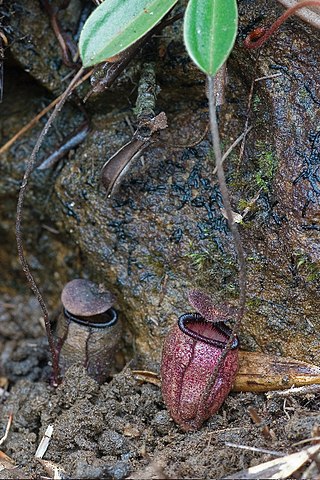
Nepenthes argentii is a highland Nepenthes pitcher plant native to Mount Guiting-Guiting on Sibuyan Island in the Philippines. It is possibly the smallest species in the genus and does not appear to have a climbing stage.
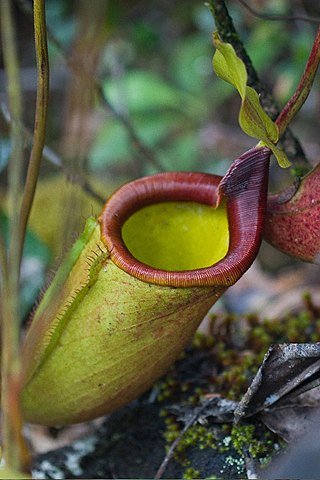
Nepenthes deaniana is a tropical pitcher plant endemic to the Philippines, where it grows at an altitude of 1180–1296 m above sea level. The species is known only from the summit region of Thumb Peak, a relatively small, ultramafic mountain in Puerto Princesa Province, Palawan.
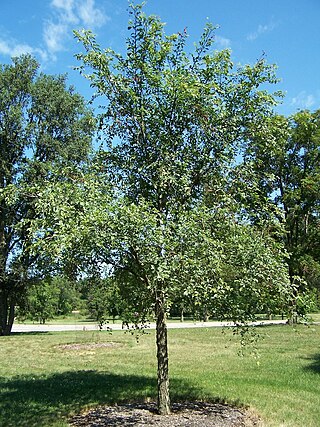
Ulmus chenmouiW. C. Cheng, commonly known as the Chenmou, or Langya Mountain elm, is a small deciduous tree from the more temperate provinces of Anhui and Jiangsu in eastern China, where it is found at elevations below 200 m on the Langya Shan and Baohua Shan mountains. The tree was unknown in the West until 1979, when seeds were sent from Beijing to the De Dorschkamp research institute at Wageningen in the Netherlands.
Elaeocarpus gigantifolius is a species of flowering plant in the Elaeocarpaceae family. It is found only in the Philippines.
Artocarpus treculianus is a species of plant in the family Moraceae. It is endemic to the Philippines. It is threatened by habitat loss. Local names include chipuho and tipuho.
Baccaurea odoratissima is a species of plant in the family Phyllanthaceae. It is endemic to the Philippines.
Hopea foxworthyi is an evergreen tree of the family Dipterocarpaceae. It is endemic to Sibuyan Island in the Philippines.
Kibatalia gitingensis is a species of plant in the family Apocynaceae. It is endemic to the Philippines.
Kibatalia macgregori is a species of plant in the family Apocynaceae. It is endemic to the Philippines.
Macaranga attenuata is a species of plant in the family Euphorbiaceae. It is endemic to the Society Islands of French Polynesia, where it is found on Moorea, Raiatea, and Tahiti.
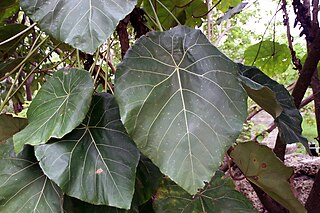
Macaranga grandifolia is a species of flowering plant in the family Euphorbiaceae. Common names for this plant include nasturtium tree, parasol leaf tree and bingabing. It is endemic to the Philippines and has been widely cultivated in Hawaii as a tropical ornamental. This plant has become very popular garden ornamental in many parts of the tropics for the extraordinary grandiose leaves, which are rounded-ovate in shape, with prominent, reddish veins and the stem attached towards the center of the leaf blade. The flowers are pinkish red and the males are held in coral-like, congested inflorescences. Twine made from the bark and the wood was used for fishing spears. The leaves were used to wrap food. Birds eat the ripe fruit.
Macaranga huahineensis is a species of plant in the family Euphorbiaceae. It is endemic to French Polynesia.
Macaranga mauritiana is a species of plant in the family Euphorbiaceae. It is endemic to Mauritius.
Macaranga quadricornis is a species of plant in the family Euphorbiaceae. It is a tree endemic to Peninsular Malaysia. It is threatened by habitat loss.
Macaranga raivavaeensis is a species of plant in the family Euphorbiaceae. It is endemic to French Polynesia.
Macaranga taitensis is a species of plant in the family Euphorbiaceae. It is endemic to French Polynesia.
Macaranga venosa is a species of plant in the family Euphorbiaceae. It is endemic to French Polynesia.
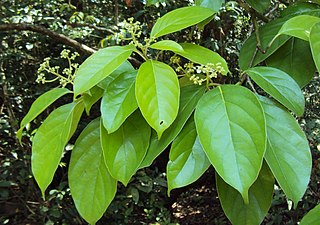
Mastixia is a genus of about 19 species of resinous evergreen trees, usually placed in the family Cornaceae. Its range extends from India through Southeast Asia and New Guinea to the Solomon Islands. Mastixia species have alternate or opposite simple broad leaves, many-flowered inflorescences, and blue to purple drupaceous fruits.







